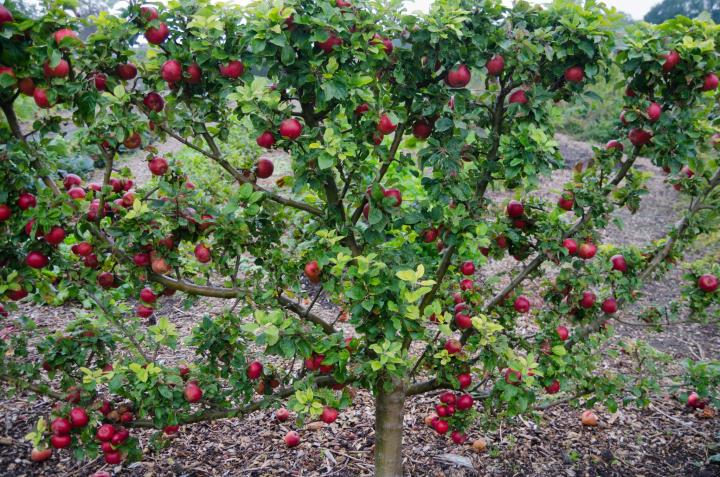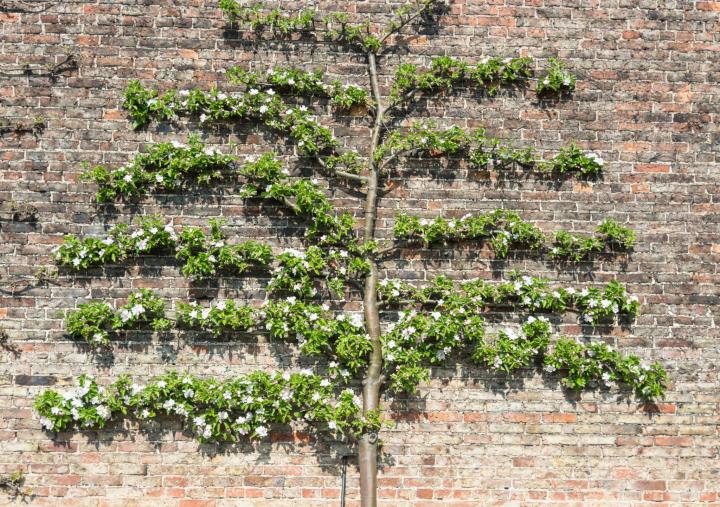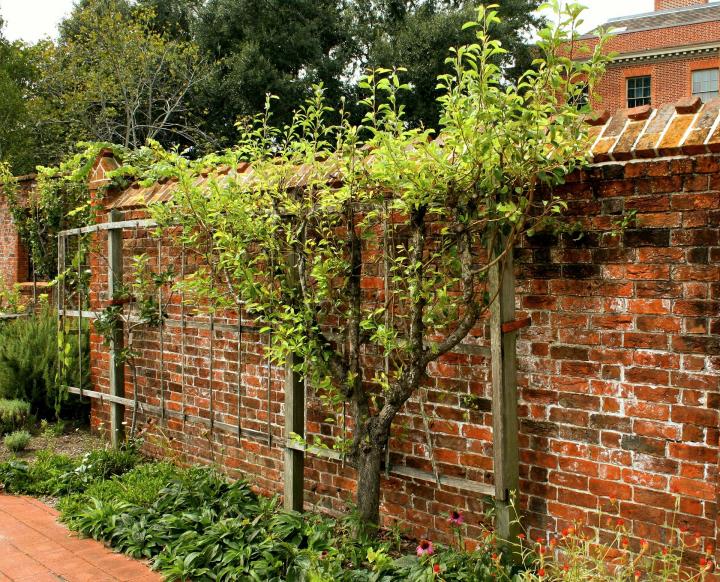Want to grow a fruit tree but short on garden space? Here’s how to espalier your fruit tree—so it grows flat against a building wall or fence. This is a common technique for apple trees but works with pears, peaches, and other fruits. It’s sure to be an eye-catcher and also helps fruit grow better in many climates.
While there are dwarf fruit trees available, even those trees are too large for many gardens or yards.
WHAT IS AN ESPALIER?
An espalier is created by pruning a tree or shrub so that it grows in a single plane. The technique was used to grow grapes in ancient Greece and Rome and was later refined in the walled settlements of medieval Europe.
With growing space at a premium, fruit trees were planted against the parapets and pruned flat. South- and west-facing walls heated by the Sun provided a warm microclimate that extended the growing season, giving the fruit more time to ripen. The open pruning allowed lots of sunlight to reach every part of the plant, enhancing fruit color and boosting yields.
Today, home gardeners have embraced espaliers as unique garden features. They are ideal for small garden spaces or patios where a tall plant is needed. Plus, if you live in a cold winter or cool summer climate, some fruits just won’t grow and mature well without this technique.
Espaliers needn’t be limited to walls and fences. They can be grown on wire frames and used as hedges, screens, garden dividers, or borders for paths. A single espaliered plant may be used instead of a garden ornament and displayed as a piece of living art.

BEST TREES FOR ESPALIER
There are an amazing number of plants that can be trained as espaliers.
Of course, fruit is a natural, including apples, pears, peaches, and other tree fruits. You’ll want to chose a dwarf (or sem-dwarf) variety.
Also, consider flowering shrubs such as forsythia and upright cotoneaster and evergreens such as holly and yew.

HOW TO ESPALIER
Easy designs for beginning espalier enthusiasts are a fan or T-shape branch arrangement. More challenging designs include the basket weave, candelabra, and diamond motifs.
- Choose a small container plant that already has spreading branches in the pattern you want.
- Choose a location that gets enough sunlight (6 to 8 hours) with fertile, well-draining soil. A south-, east-, or west-facing wall or fence is ideal.
- Provide a wire framework set 6 to 8 inches out from the wall. If creating an espalier along a fence, run heavy-gauge wires between posts set in the ground to create three horizontal lines. If you’re running wires along a wall, you’ll need to set nails in the wall..
- Plant your tree in the middle of your designed trellis wire system about 6 inches away from the wire structure. Position the plant so that at least two of the strongest branches run in the direction of the wires.
- Remove all but two shoots on each branch. Secure remaining branches to the wires with a soft tie.
- Gently guide the remaining branches so that they will start to form the pattern you want.
- As the central trunk grows, keep removing side shoots. When the trunk reaches the next wire up, allow two side shoots to develop (remove the rest) and attach them to the wires.
- Water and fertilize the tree to keep it healthy. Each year, keep pruning the tree to maintain its shape.
ESPALIER APPLE TREE VARIETIES
Apple trees are an especially popular tree to espalier. According to the National Gardening Association:
While any apple can be espaliered, for a horizontal cordon system, choose a dwarf or semi-dwarf, spur-type apple variety. ‘Macintosh’ and its many crosses are good choices for the horizontal cordon system because their branches tend to grow horizontally already. ‘Golden Delicious’ is a nice choice if you only have room for one tree because it is self-fertile. ‘Liberty’ and ‘Honeycrisp’ are good modern varieties because they are disease resistant and require less spraying. With fruit trees, you’ll want to prune out any developing fruit the first few years. You may have to prune 2 to 3 times a year to keep the tree in shape.
It may take 2 or 3 years of training to create an espalier using a simple design and several years for one more complex. Don’t despair if at first the plant doesn’t seem to be cooperating. Espaliers, like some people, seem to have a way of shaping up when their back’s up against the wall.
Source / The Old Farmer’s Almanac

